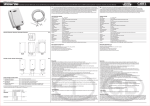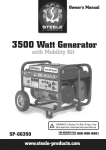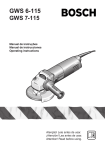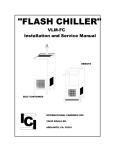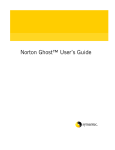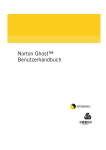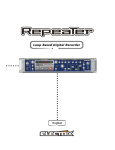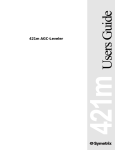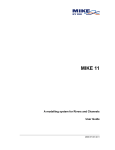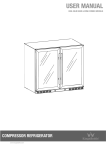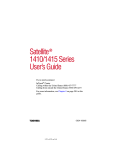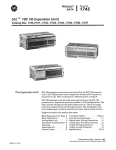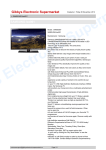Download User`s Manual - Cyber Power Systems
Transcript
User’s Manual STP3T40KE STP3T60KE STP3T80KE STP3T100KE STP3T120KE CyberPower Systems Inc. www.cpsww.com Safety Precautions Safety Precautions This manual contains information concerning the installation and operation of high frequency UPS.Please carefully read this manual prior to installation. The UPS cannot be put into operation until it is commissioned by engineers approved by the manufacturer (or its agent). Not doing so could result in personnel safety risk, equipment malfunction andinvalidation of warranty. The UPS has been designed for commercial or industrial use only, and is not intended for use in any life supportapplication.This is a CLASS C Uninterruptible Power Supply (UPS) product. In a domestic environment, this product maycause radio interference, in which case, the user may be required to take additional measures. Conformity and standards This product complies with CE73/23 & 93/68 (low voltage safety) and 89/336 (EMC), and the following UPS product standards: *IEC62040-1-1-General and safety requirements for use in operator access area *IEC/EN62040-2 EMC requirements CLASS C *IEC62040-3 Performance requirements and test methods For more details, refer to Chapter 9.Continued compliance requires installation in accordance with these instructions and the use of manufacturer approvedaccessories only. WARNING: high earth leakage current Earth connection is critical before connecting the input supply (include both utility supply and battery). "Earth leakage current introduced by the UPS, in any configuration from 40kW to 120kW, exceeds 3.5mA and is less than1000mA and complies with the requirements of IEC/EN 62040-1/IEC/EN 60950-1" Transient and steady-state earthleakage currents, which may occur when starting the equipment, should be taken into account when selecting instantaneousRCCB or RCD devices. Residual Current Circuit Breakers (RCCBs) must be selected sensitive to DC unidirectional pulses (class A) and insensitiveto transient current pulses. Note also that the earth leakage currents of the load will be carried by this RCCB or RCD. This equipment must be earthed in accordance with local electrical authority codes of practice. WARNING: back-feed protection This system has a control signal available for use with an automatic device, externally located, to protect againstback-feed voltage through the mains Static Bypass circuit. If this protection is not used with the switchgear that is used toisolate the bypass circuit, a label must be added to the switchgear to advise service personnel that the circuit is connected toa UPS system. The text has the following meaning or is equivalent to: Isolate the UPS before working on the circuit of this UPS. Components that can be maintained by user All the equipment maintenance and servicing procedures involving internal access need special tools and should be carriedout only by trained personnel. The components that can only be accessed by opening the protective cover with tools cannotbe maintained by user. This UPS full complies with “IEC62040-1-1-General and safety requirements for use in operator access areaUPS”. Dangerous voltages are present within the battery box. However, the risk of contact with these high voltages isminimized for non-service personnel. Since the component with dangerous voltage can only be touched by opening theprotective cover with a tool, the possibility of touching high voltage component is minimized. No risk exists to any personnelwhen operating the equipment in the normal manner, following the recommended operating procedures in this manual. Smart Tower UPS 40KVA~120KVA User Manual I Safety Precautions Battery voltage higher than 400Vdc All the battery maintenance and servicing procedures involving internal access need special tools or keys and should becarried out only by trained personnel. SPECIAL CARE SHOULD BE TAKEN WHEN WORKING WITH THE BATTERIES ASSOCIATED WITH THIS EQUIPMENT. WHEN CONNECTED TOGETHER, THE BATTERY TERMINAL VOLTAGE WILL EXCEED 400Vdc AND IS POTENTIALLYLEATHAL. Battery manufacturers supply details of the necessary precautions to be observed when working on, or in the vicinity of, alarge bank of battery cells. These precautions should be followed implicitly at all times. Particular attention should be paid tothe recommendations concerning local environmental conditions and the provision of protective clothing, first aid andfire-fighting facilities. II Smart Tower UPS 40KVA~120KVA User Manual Contents Contents Safety Precautions ................................................................................................................ I Chapter 1 Installation ........................................................................................................... 1 1.1 Introduction ............................................................................................................. 1 1.2 Initial Checking ........................................................................................................ 1 1.3 Location .................................................................................................................. 1 1.3.1 UPS Location ................................................................................................ 1 1.3.2 External Battery Room................................................................................... 2 1.3.3 Storing........................................................................................................... 2 1.4 Positioning............................................................................................................... 2 1.4.1 System Cabinet ............................................................................................. 2 1.4.2 Moving the Cabinets ...................................................................................... 3 1.4.3 Clearances Required for Operating ............................................................... 3 1.4.4 Front Access.................................................................................................. 3 1.4.5 Final Positioning ............................................................................................ 3 1.4.6 Installation of Adjustable Feet ........................................................................ 3 1.4.7 UPS Composition .......................................................................................... 3 1.4.8 Cable Entry ................................................................................................... 5 1.5 External Protective Devices ..................................................................................... 5 1.5.1 Rectifier and Bypass Input Supply of the UPS ............................................... 5 1.5.2 External Battery ............................................................................................. 6 1.5.3 UPS Output ................................................................................................... 6 1.6 Power Cables .......................................................................................................... 6 1.6.1 Cable Connections ........................................................................................ 7 1.7 Control Cabling and Communication ....................................................................... 8 1.7.1 UPS Dry Contact GJ and Monitoring Board FK Features ............................... 8 1.7.2 Dry Contact Interface of Battery and Environmental Temperature Detection .. 8 1.7.3 Remote EPO Input Port ................................................................................. 9 1.7.4 Generator Input Dry Contact .......................................................................... 9 1.7.5 BCB Input Port ............................................................................................ 10 1.7.6 Battery Warning Output Dry Contact Interface .............................................. 11 1.7.7 Integrated Warning Output Dry Contact Interface.......................................... 11 1.7.8 Mains Failure Warning Output Dry Contact Interface ................................... 12 Chapter 2 Battery Installation ............................................................................................. 13 2.1 General Recommendations ................................................................................... 13 2.2 Battery Typologies ......................................................................................... 14 2.2.1 Battery Installation ....................................................................................... 14 2.3 Battery Maintenance.............................................................................................. 15 Smart Tower UPS 40KVA~120KVA User Manual III Contents Chapter 3 Installation of Single UPS and Parallel System................................................... 16 3.1 Overview ............................................................................................................... 16 3.2 UPS in Parallel System ......................................................................................... 16 3.2.1 Installation of Cabinet .................................................................................. 16 3.2.2 External Protective Devices ......................................................................... 17 3.2.3 Power Cables .............................................................................................. 17 3.2.4 Parallel Signal Board ................................................................................... 17 3.2.5 Control Cables............................................................................................. 17 Chapter 4 Installation Drawing............................................................................................ 19 Chapter 5 Operations ......................................................................................................... 23 5.1 Introduction ........................................................................................................... 23 5.1.1 Split-Bypass Input........................................................................................ 23 5.1.2 Static Transfer Switch .................................................................................. 24 5.2 1+1 Parallel System .............................................................................................. 24 5.2.1 Features of Parallel System ......................................................................... 24 5.2.2 Parallel Requirements of UPS Modules ....................................................... 24 5.3 Operating Mode..................................................................................................... 25 5.3.1 Normal Mode ............................................................................................... 25 5.3.2 Battery Mode ............................................................................................... 25 5.3.3 Auto-Restart Mode....................................................................................... 25 5.3.4 Bypass Mode............................................................................................... 25 5.3.5 Cold Start Mode .......................................................................................... 25 5.3.6 Maintenance Mode (Manual Bypass) ........................................................... 25 5.3.7 Parallel Redundancy Mode (System Expansion) ......................................... 25 5.3.8 Eco Mode .................................................................................................... 25 5.4 Battery Management—Set During Commissioning ................................................ 26 5.4.1 Normal Function .......................................................................................... 26 5.4.2 Advanced Functions (Software Settings Performed by the Commissioning Engineer) ............................................................................................................. 26 5.5 Battery Protection (Settings by Commissioning Engineer) ..................................... 26 Chapter 6 Operating Instructions ........................................................................................ 27 6.1 Introduction ........................................................................................................... 27 6.1.1 Power Switches ........................................................................................... 27 6.2 UPS Startup .......................................................................................................... 27 6.2.1 Start-Up Procedure...................................................................................... 27 6.2.2 Procedures for Switching Between Operation Modes .................................. 28 6.3 Procedure for Switching the UPS between Maintenance Bypass and Normal Mode .................................................................................................................................... 29 6.3.1 Procedure for Switching from Normal Mode to Maintenance Bypass Mode.. 29 6.3.2 Procedure for Switching from Maintenance Mode to Normal Mode .............. 30 IV Smart Tower UPS 40KVA~120KVA User Manual Contents 6.4 Procedure for Completely Powering Down a UPS ................................................. 30 6.5 EPO Procedure ..................................................................................................... 30 6.6 Auto Start .............................................................................................................. 30 6.7 UPS Reset Procedure ........................................................................................... 30 6.8 Language Selection ............................................................................................... 31 6.9 Changing the Current Date and Time .................................................................... 31 6.10 Control Password 1 ............................................................................................. 31 Chapter 7 Operator Control and Display Panel ................................................................... 32 7.1 Introduction ........................................................................................................... 32 7.1.1 Mimic Current Path ...................................................................................... 33 7.1.2 Audible Alarm (buzzer)................................................................................. 33 7.1.3 Functional Keys ........................................................................................... 33 7.2 LCD Display Type .................................................................................................. 34 7.3 Detailed Description of Menu Items ....................................................................... 35 7.4 UPS Event Log ...................................................................................................... 36 Chapter 8 Optional Parts .................................................................................................... 40 8.1 Replacing Dust Filters ........................................................................................... 40 Chapter 9 Product Specification ......................................................................................... 41 9.1 Applicable Standards ............................................................................................. 41 9.2 Environmental Characteristics ............................................................................... 41 9.3 Mechanical Characteristics .................................................................................... 41 9.4 Electrical Characteristics (Input Rectifier) .............................................................. 42 9.5 Electrical Characteristics (Intermediate DC Link) ................................................... 42 9.6 Electrical Characteristics (Inverter Output) ............................................................. 42 9.7 Electrical Characteristics (Bypass Input) ................................................................ 43 9.8 Efficiency ............................................................................................................... 44 Smart Tower UPS 40KVA~120KVA User Manual V Contents Table of Figures Fig.1- 1: UPS Structure ............................................................................................................. 5 Fig.1- 2: The Symbols of RCCB................................................................................................... 6 Fig.1- 3: Bypass Module (Include Interface of Dry Contact Board GJ and Monitoring Board FK) ......... 8 Fig.1- 4: Diagram of J2 and J3 Dry Contact of Temperature Detection ............................................ 8 Fig.1- 5: Diagram of Input Dry Contact for Remote EPO................................................................ 9 Fig.1- 6: Connection of Generator ........................................................................................... 10 Fig.1- 7: BCB Interface ........................................................................................................... 10 Fig.1- 8: Battery Low Warning Dry Contact ................................................................................ 11 Fig.1- 9: Integrated warning dry contact.................................................................................... 11 Fig.1- 10: Utility Failure Warning Dry Contact ........................................................................... 12 Fig.2- 1: Diagram of Batteries Connection ................................................................................ 14 Fig.3- 1: Circuit diagram of EPO............................................................................................... 16 Fig.3- 2: Installation of Parallel Signal Board BJ.......................................................................... 17 Fig.3- 3: Connection of Parallel Control Cables of “1+N” System .................................................. 18 Fig.4- 1: Wiring Diagram ....................................................................................................... 19 Fig.4- 2: External Battery Connection .................................................................................. 19 Fig.4- 3: 40KVA UPS, Front View without Doors ................................................................ 20 Fig.4- 4: 60KVA-80KVA UPS, Front View without Door...................................................... 20 Fig.4- 5: 100KVA/120KVA UPS, Front View without Door.................................................. 21 Fig.5- 1: Single Unit Block Diagram .......................................................................................... 23 Fig.6- 1: Location of Battery Cold Start Button .......................................................................... 29 Fig.7- 1: UPS operator control and display panel ....................................................................... 32 Fig.7- 2: Main LCD Display ...................................................................................................... 34 Fig.8- 1: Location of Dust Filter ............................................................................................... 40 VI Smart Tower UPS 40KVA~120KVA User Manual Table of Tables Table of Tables Table.1- 1: UPS Configuration List .............................................................................................. 5 Table.1- 2: Maximum Steady State AC and DC Current ................................................................. 6 Table.1- 3: Description of Input Dry Contact ............................................................................... 8 Table.1- 4: Description of Input Dry Contact for Remote EPO ........................................................ 9 Table.1- 5: Description of Status Interface and Connection of Generator ...................................... 10 Table.1- 6: Description of BCB Interface ................................................................................... 10 Table.1- 7: Battery warning dry contact interface description ...................................................... 11 Table.1- 8: Integrated warning dry contact interface description .................................................. 11 Table.1- 9: Description of Mains failure warning dry contact ....................................................... 12 Table.7- 1: Description of UPS Operator Control and Display Panel .............................................. 32 Table.7- 2: Status Description of Indicator ................................................................................ 33 Table.7- 3: Description of Audible Alarm .................................................................................. 33 Table.7- 4: Functions of Functional Keys ................................................................................... 33 Table.7- 5: Description of LCD Icons ......................................................................................... 34 Table.7- 6: Description of Items in UPS System Information Window ........................................... 35 Table.7- 7: Item Description of UPS Menu ................................................................................ 35 Table.7- 8: UPS Event List ....................................................................................................... 36 Table.9- 1: Compliance with European and International Standards ............................................ 41 Table.9- 2: Environmental Properties ....................................................................................... 41 Table.9- 3: Mechanical Properties ........................................................................................... 41 Table.9- 4: Rectifier AC Input (mains) ....................................................................................... 42 Table.9- 5: Battery Information ............................................................................................... 42 Table.9- 6: Inverter Output (to Critical Load) ............................................................................. 42 Table.9- 7: Bypass Input ......................................................................................................... 43 Table.9- 8: Efficiency, Air Exchange .......................................................................................... 44 Smart Tower UPS 40KVA~120KVA User Manual VII Chapter 1 Installation Chapter 1 Installation 1.1 Introduction This chapter introduces the relevant requirements for positioning and cabling of the UPS and related equipment.Because each site has its requirements, it is not the aim of this chapter to provide step-by-step installationinstructions, but to act as a guide for the general procedures and practices that should be observed by the installingengineer. Warning: installation can only be done by authorized engineers Do not apply electrical power to the UPS equipment before the commissioning engineer arrives at installation site. The UPS should be installed by a qualified engineer in accordance with the information contained in this chapter. All theequipment not referred to in this manual is shipped with details of its own mechanical and electrical installation information. Note: 3-Phase 4-Wire Input Power is required The standard UPS system can be connected to TN, TT AC distribution system (IEC60364-3) of 3-phase 4-wire, and a 3-wire to 4-wire conversion transformer is provided as an optional part. WARNING: battery hazards SPECIAL CARE SHOULD BE TAKEN WHEN WORKING WITH THE BATTERIES ASSOCIATED WITH THIS EQUIPMENT. When connecting the battery, the battery terminal voltage will exceed 400Vdc and is potentially lethal. Eye protection should be worn to prevent injury from accidental electrical arcs. Remove rings, watches and all metal objects. Only use tools with insulated handles. Wear rubber gloves. If a battery leaks electrolyte, or is otherwise physically damaged, it must be replaced, stored in a container resistant to sulfuric acidand disposed of in accordance with local regulations. If electrolyte comes into contact with the skin, the affected area should be washed immediately with water. 1.2 Initial Checking Perform the following checking operations prior to the UPS installation. 1. Visually examine if there is any damage inside and outside the UPS rack and battery equipment due to thetransportation. Report any such damage to the shipper immediately. 2. Verify the product label and confirm the correctness of the equipment. The equipment label is attached on the backof front door. The UPS model, capacity and main parameters are marked on the label. 1.3 Location 1.3.1 UPS Location The UPS is intended for indoor installation and should be located in a cool, dry and clean environment with adequate ventilation to keep the environmental parameters within the specified operating range (see Table.9-2).The UPS uses forced convection cooling by internal fans. Cooling air enters the modulethrough ventilation grills located at the front part of the cabinet and exhausted through grills located in the rear part ofthe cabinet. Please do not block the ventilation holes. If necessary, a system of extractor fans should be installed to aid cooling-air flow. An air filter should be used whenthe UPS Smart Tower UPS 40KVA~120KVA User Manual 1 Chapter 1 Installation is to operate in a dirty environment and should be regularly cleaned to maintain airflow.The cooling capacity of air conditioner should be selected according to the power loss data of UPS specified in Table.9-8: Normal mode (VFI SS 111 double-conversion UPS) Note: The UPS should be installed on a cement surface or other surface that is not combustible. 1.3.2 External Battery Room The battery will generate some amount of hydrogen and oxygen at the end of charging, so the fresh air volume of thebattery installation environment must meet EN50272-2001 requirements. The ambient temperature of the battery must be stable. Ambient temperature is a major factor in determining thebattery capacity and life. The nominal operating temperature of battery is 20°C. Operating above this temperature willreduce the battery life, and operation below this temperature will reduce the battery capacity. If the average operatingtemperature of battery is increased from 20ºC to 30ºC, then the service life of the battery will be reduced by 50%. Ifthe operating temperature of the battery is above 40ºC, then the battery service life will be decreased in exponentrate. In a normal installation, the battery temperature is maintained between 15°C and 25°C. Keep batteries awayfrom heat sources or air outlets. If external batteries are to be used, the battery circuit breakers (or fuses) must be mounted as close as possible to the batteries, and the connecting cables should be as short as possible. 1.3.3 Storing Should the equipment not be installed immediately, it must be stored in a room so as to protect it against excessivehumidity and heat sources (see Table.9-2).The battery needs to be stored in dry and cool place with good ventilation.The most suitable storage temperature is 20 ºC to 25ºC. Preventing battery deep discharge Should the UPS remain unpowered for a prolonged period of time while the batteries are connected, the batteries may deeplydischarge and being permanently damaged.In such cases it is therefore recommended to leave the battery circuit breaker(s)open. During storage in any case, periodically charge the battery according to the battery user manuals. 1.4 Positioning When the equipment has been finally positioned, ensure the UPS will remain stationary and stable. To prolong theservice life, the place chosen must guarantee: Space for easy operation on the UPS Air sufficient enough to dispel heat produced by UPS Against atmospheric agents Against excessive humidity and heat sources Against dust With the current fire prevention requirements The operating environment temperature is within +20°C to +25°C. The batteries are at maximum efficiency inthis temperature range (for information about the battery storage and transportation as well as the environment,refer to Table.9-2 ) This equipment is of steel frame structure wrapped by removable panels. The top and side panels are fixed byscrews. After opening the UPS rack door, the auxiliary connections for external low voltage interface and the maintenancebypass can be accessed. The UPS rack has an operator and control panel located on its front door, which providesthe basic operating status and alarm information. Batteries are external. The UPS provides air inlet port in the frontand the air exhaust port in the rear part. 1.4.1 System Cabinet All the UPS system cabinets used in the same installation site are of the same height and should be positionedside-by-side to achieve an aesthetically appealing effect.Refer to Chapter 7 Installation Drawing for the positioning of UPS cabinet. 2 Smart Tower UPS 40KVA~120KVA User Manual Chapter 1 Installation 1.4.2 Moving the Cabinets Warning Ensure that any lifting equipment used in moving the UPS cabinet has sufficient lifting capacity.The UPS is fitted with castors – take care to prevent movement when unbolting the equipment from its shipping pallet. Ensureadequate personnel and lifting aids are available when removing the shipping pallet. Ensure that the UPS weight is within the weight loading capacity range of any hoisting equipment. See Table.9-3 forUPS weight. UPS and optional cabinets can be handled by means of a fork lift or similar equipment. The UPS cabinet can also be moved by its castors when moving in a short distance. Note:Care must be taken when handling units fitted with batteries. Keep such moves to a minimum. 1.4.3 Clearances Required for Operating As UPS has no ventilation grills at either sides, no clearances are required for the sides. To enable routine tightening of power terminations within the UPS, it is recommended that clearance around the front of the equipment should be sufficient to enable free passage of personnel with the doors fully opened. It is important to leave a distance of 500mm in the rear side of the rack to permit adequate circulation of air coming out of the unit. 1.4.4 Front Access The component layout of the UPS supports front and rear access and repairing the UPS, thus reducing the space requirement for side access. 1.4.5 Final Positioning When the equipment has been finally positioned, ensure the adjustable feet are set so that the UPS will remainstationary and stable. 1.4.6 Installation of Adjustable Feet Installation diagrams in Chapter 4 of this manual identify the location of the holes in the base plate through whichthe equipment can be bolted to the floor. If the UPS is to be located on a raised floor, it should be mounted on apedestal suitably designed to accept the UPS point loading (more than 800 kg). 1.4.7 UPS Composition The UPS structure is shown in Fig. 1-1. The UPS configuration is provided in Table. 1-1 Smart Tower UPS 40KVA~120KVA User Manual 3 Chapter 1 Installation (a) (b) 4 100kVA/120kVA cabinet 60kVA/80kVA cabinet Smart Tower UPS 40KVA~120KVA User Manual Chapter 1 Installation (c) 40kVA cabinet Fig.1- 1: UPS Structure Table.1- 1: UPS Configuration List Item Component 1 System Display Quantity 1 Remarks Requisite, factory installed 2 3 Bypass module Input/bypass/output/maintenance bypass breakers 1 1 Requisite, factory installed Requisite, factory installed 4 Power unit 2 ≤n ≤6 Requisite, factory installed 1.4.8 Cable Entry Cables can enter the UPS and battery cabinet both from bottom and top. Cable entry is madepossible through a blanking plate fitted at the bottom or top of the equipment. The recommended installation practice is toinstall glands to prevent foreign material or vermin entering the cabinet. 1.5 External Protective Devices For safety concerns, it is necessary to install external circuit breakers or other protective devices for the input ACsupply of the UPS system. This section provides generic practical information for qualified installation engineers. Theinstallation engineers should have the knowledge of the regulatory wiring standards, and of the equipment to beinstalled. 1.5.1 Rectifier and Bypass Input Supply of the UPS Over currents Install suitable protective devices in the distribution unit of the incoming mains supply, considering the power cablecurrent-carrying capacity and overload capacity of the system (see Tab. 9-7). Generally, the circuit breaker with IEC60947-2 tripping curve C (normal) at the 125% of the current listed in Tab. 9-7 is recommended.In case a split bypass is used, separate protective devices should be installed for the rectifier input andbypass input in the incoming mains distribution panel. Note:The rectifier input and bypass input must use the same neutral line. Protection against earth faults (RCD devices): The RCD device installed upstream of the input supply should: Sensitive to DC unidirectional pulses (class A) in the network Insensitive to transient current pulses Have an average sensitivity that is adjustable between 0.3A and 1A. Smart Tower UPS 40KVA~120KVA User Manual 5 Chapter 1 Installation Fig.1- 2: The Symbols of RCCB When using the RCD in the split bypass system or parallel system, the RCD should be installed in the upstream ofthe input distribution to avoid wrong alarm. The residual current introduced by RFI filter in the UPS is between 3.5mA and 1000mA. It is recommended to confirm the sensitivity of each RCD of upstream input distribution and downstream distribution (to load). 1.5.2 External Battery The DC compatible circuit breaker provides over current protection for UPS system and battery, which is provided by the external battery cabinet. 1.5.3 UPS Output In the eventuality that an external distribution panel is used for load distribution, the selection of protective devicesmust provide discrimination with those that are used at the input to the UPS (see Tab. 9-7). 1.6 Power Cables Design the cables according to the descriptions in this section and local regulatory wiring standards, and theenvironmental conditions (temperature and physical support media) should be taken into consideration. Refer toIEC60950-1 Table 3B Cabling. WARNING FAILURE TO FOLLOW ADEQUATE EARTHING PROCEDURES CAN RESULT IN EMI, ELECTRIC SHOCK HAZARD, OR RISKOF FIRE, SHOULD AN EARTH FAULT OCCUR. 120 Table.1- 2: Maximum Steady State AC and DC Current Rated current (A) Main input current at full load Battery discharging current at Output current at full load2 battery charging1,2 E.O.D=1.67V/cell, no overload 36 38 40 380V 400V 415V 380V 400V 415V Batt./strin Batt./string Batt./string g 184 175 168 182 173 166 281 266 253 100 80 60 153 124 92 UPS power( KVA) 146 118 88 140 112 84 152 122 91 144 136 87 139 112 83 234 188 142 222 178 133 211 170 127 40 62 59 56 61 68 56 94 89 85 Note: 1. Input current of common input configurations of rectifier and bypass 2. Take special care when determining the size of the output and bypass neutral cable, as the current circulating onthe neutral cable may be greater than nominal current in the case of non-linear loads, which is usually 1.732 times ofrated currents. 3. The earth cable connecting the UPS to the main ground system must follow the most direct routepossible. The earth conductor should be sized according to the fault rating, cable lengths, type of protection, etc. According to AS/IEC60950-1, the cross section area of the conductor is 50mm2 (120KVA), the cross section area of the 2 conductor is 35mm . 4. When sizing battery cables, a maximum volt drop of 4Vdc. is permissible at the current ratings given in Table.1-2.The load equipment is connected to a distribution network of individually protected busbars fed by the UPS outputrather than connected directly to the UPS. In parallel systems, the output cable of each ups rack unitshould be kept at equal length 6 Smart Tower UPS 40KVA~120KVA User Manual Chapter 1 Installation between the output of the ups rack output terminals and the parallel distribution busbarsto avoid affecting the shared current. When laying the power cables, do not form coils, so as to avoid the formation ofelectromagnetic interference. 5. See Chapter 4 Installation Drawing for the positions of wiring terminals. WARNING FAILURE TO FOLLOW ADEQUATE EARTHING PROCEDURES CAN RESULT IN EMI, ELECTRIC SHOCK HAZARD OR RISKOF FIRE, SHOULD AN EARTH FAULT OCCUR. 1.6.1 Cable Connections Note The operations described in this section must be performed by authorized electricians or qualified technical personnel. If you have any difficulties, do not hesitate to contact our Customer Service & Support department. After the equipment has been finally positioned and secured, refer to Chapter 4 Installation Drawing to connect the power cables as described in the following procedures: 1. Verify that all the external input distribution switches of the UPS are completely opened and the UPS internal maintenance bypass switch is opened. Attach necessary warning signs to these switches to prevent unauthorized operation. 2. Open rear panel of the UPS, and then the power connection terminals are visible. 3. Connect the protective earth and any necessary grounding cables to the PE terminal.The cabinet for the UPS must be connected to the user’s ground connection. Note: The grounding cable and neutral cable must be connected in accordance with local and national codes practiceIdentify and make power connections for incoming cables according to one of the two procedures below, depending on the type of installation: Common Input Connections 4. For common bypass and rectifier inputs, connect the AC input supply cables to the UPS input terminals (mA-mB-mC-mN) Refer to Fig. 4-11 and tighten the connections to 5 Nm (M6 Bolt), 13Nm(M8 Bolt).ENSURE CORRECT PHASE ROTATION. Split Bypass Connections 5. If a 'split-bypass' configuration is used, connect the AC input supply cables to the rectifier input terminals (mA-mB-mC-mN) Refer to Fig.4-11 and the AC bypass supply cables to the bypass input terminals (bA-bB-bC-mN) and tighten the connections to 5 Nm (M6 Bolt) or 13Nm (M8 Bolt) or 25Nm (M10 Bolt). ENSURE CORRECT PHASE ROTATION. Note: For split Bypass operation ensure that the bus-bars between Bypass and Rectifier inputs are removed. The neutral line of bypass input must be connected to that of the rectifier input. Frequency Converter Mode If the frequency converter configuration is used, connect the AC input cables to the rectifier input terminals (mA-mB-mC-mN) Refer to Fig.4-11 and tighten the connections to 5Nm (M6 bolt), or to 13Nm (M8 bolt). ENSURE CORRECT PHASE ROTATION AND TIGHTEN CONNECTION TERMINALS. No need to connect the bypass input cables to bypass input terminals (bA-bB-bC-mN). Note: For the frequency converter operation mode, ensure that the bus-bars between Bypass and Rectifier inputs are removed. Output System Connections 6. Connect the system output cables between the UPS output bus-bars (oA-oB-oC-oN) Refer to Fig.4-11 and the critical load and tighten the connections to 5Nm (M6 Bolt) or to 13Nm (M8 Bolt). ENSURE CORRECT PHASE ROTATION. WARNING If the load equipment will not be ready to accept power on the arrival of the commissioning engineer, then ensure that the systemoutput cables are safely isolated at their ends. 7. Re-install all the protective covers. Smart Tower UPS 40KVA~120KVA User Manual 7 Chapter 1 Installation 1.7 Control Cabling and Communication 1.7.1 UPS Dry Contact GJ and Monitoring Board FK Features According to the specific needs of the field, the UPS may need auxiliary connection to realize the management of thebattery system (including external battery switch and battery temperature sensor), communicate with PC, providealarm signal to external device, or realize remote EPO. These functions are realized through the UPS dry contact board (GJ)and monitoring board (JK) at the front of bypass module. The boardsprovide the following interfaces: EPO Environment and battery temperature input interface Generator input dry contact interface Battery warning output dry contact interface Battery circuit breaker interface Mains failure warning output dry contact interface Intellislots(TM) intelligent card interface User communication interface The UPS dry contact board GJ provides input dry contacts and output dry contacts. Fig.1- 3: Bypass Module (Include Interface of Dry Contact Board GJ and Monitoring Board FK) 1.7.2 Dry Contact Interface of Battery and Environmental Temperature Detection The input dry contact J2 and J3 detect the temperature of batteries and environment respectively, which can be used in environment monitoring and battery temperature compensation. J2 and J3 interfaces diagram are shown in fig.1-4, and the description of interface is in table.1-3. Fig.1- 4: Diagram of J2 and J3 Dry Contact of Temperature Detection Table.1- 3: Description of Input Dry Contact Position Name Purpose J2.1 TEMP_BAT Battery temperature detection J2.2 J3.1 8 / TEMP_ENV Smart Tower UPS 40KVA~120KVA Battery temperature detection Environment temperature detection User Manual Chapter 1 Installation Position Name Purpose J2.1 J2.2 J3.1 TEMP_BAT / TEMP_ENV Battery temperature detection Battery temperature detection Environment temperature detection J3.2 / Environment temperature detection Note: Specified temperature sensor is required for temperature detection (R25=5Ohm, B25/50=3275), please confirm with the manufacturer, or contact local maintenance engineers when placing an order. 1.7.3 Remote EPO Input Port The UPS has an Emergency Power OFF (EPO) function. This function can be activated by pressing a button on the control panel of the UPS or through a remote contact provided by the user. The EPO pushbutton is protected by a hinged plastic cover. J4 is the input port for remote EPO. It requires shorting NC and +24v during normal operation, and the EPO is triggered when opening NC and +24v, or shorting NO and +24v. The port diagram is shown in fig.1-5, and port description is shown in table.1-4. Fig.1- 5: Diagram of Input Dry Contact for Remote EPO Table.1- 4: Description of Input Dry Contact for Remote EPO Position Name Purpose J4.1 EPO_NC EPO is activated when disconnecting fromJ4.2 J4.2 +24V +24V, connect the common terminal of NC and NO J4.3 EPO_NO EPO is activated when shorting with J4.2 The EPO is triggered when shorting pin 2 and 3 or opening pin 2 and 1 of J4. If an external emergency stop facility is required, it is connected via the reserved terminals of J4. The external emergency stop facility needs to use shielded cables to connect to the normally open/closed remote stop switch between these two pins. If this facility is not used, then pin 3 and pin 4 of J4 must be open, or pin 1 and pin 2 of J4 must be shorted. Note 1. The emergency stop action within the UPS will shut down the rectifier, inverter and static bypass. However, it does not internally disconnect the mains input power supply. To disconnect ALL power to the UPS, open the upstream input circuit breaker(s) when the EPO is activated. 2. Pin 1 and 2 of J4 have been shorted before the UPS is delivered. 3. All auxiliary cables must be double insulated twisted cables with cross sectional area of 0.5mm2 ~ 1.5mm2 for maximum connection length between 25m and 50m. 1.7.4 Generator Input Dry Contact J5 is the status interface for generator connection. Connect J5-2 with J5-1, it indicates that the generator has been connected with the system. The interface diagram is shown in fig.1-6, and interface description is shown in table.1-5. Smart Tower UPS 40KVA~120KVA User Manual 9 Chapter 1 Installation Fig.1- 6: Connection of Generator Table.1- 5: Description of Status Interface and Connection of Generator Position Name Purpose J5.1 J5.2 J5.3 +24V GEN GND Internal +24V power supply Generator connection Power ground Note All auxiliary cables must be double insulated twisted cables with cross sectional area of 0.5mm2 ~ 1.5mm2 for maximum connection length between 25m and 50m. 1.7.5 BCB Input Port J6 and J7 are the ports of BCB. The diagram is shown in fig.1-7, and description is shown in table.1-6. Fig.1- 7: BCB Interface Table.1- 6: Description of BCB Interface Position Name Description J6.1 BCB_DRV BCB actuating signal, provide the actuating signal of +24V, 20mA J6.2 J7.1 BCB_CONT GND J7.2 BCB_ONL BCB contact status, connect with the normally open signal of BCB Common connection BCB on-line–input (normally open) , BCB is on-line when the signal is connecting with GND Note All auxiliary cables must be double insulated twisted cables with cross sectional area of 0.5mm2 ~ 1.5mm2 for maximum connection length between 25m and 50m. 10 Smart Tower UPS 40KVA~120KVA User Manual Chapter 1 Installation 1.7.6 Battery Warning Output Dry Contact Interface J8 is the output dry contact interface, which outputs the battery warnings of low or excessive voltage, when the battery voltage is lower than set value, an auxiliary dry contact signal will be provided via the isolation of a relay. The interface diagram is shown in fig.1-8, and description is shown in table.1-7. Fig.1- 8: Battery Low Warning Dry Contact Table.1- 7: Battery warning dry contact interface description Position Name description J8.1 BAT_LOW_NC Battery warning relay (normally closed) will be open during warning J8.2 BAT_LOW_NO Battery warning relay (normally open) will be closed during warning J8.3 GND Common connection 1.7.7 Integrated Warning Output Dry Contact Interface J9 is the integrated warning output dry contact interface, when one or more than one present warning is triggered, the system will send an integrated warning information, and provide an auxiliary dry contact signal via the isolation of a relay. The interface diagram is shown in fig.1-9, and description is shown in table.1-8. Fig.1- 9: Integrated warning dry contact Table.1- 8: Integrated warning dry contact interface description Position Name Purpose J9.1 ALARM_NC Integrated warning relay (normally closed) will be open during warning J9.2 J9.3 ALARM_NO GND Integrated warning relay (normally open) will be closed during warning Common connection Smart Tower UPS 40KVA~120KVA User Manual 11 Chapter 1 Installation Position Name Purpose Note All auxiliary cables must be double insulated twisted cables with cross sectional area of 0.5mm2 ~ 1.5mm2 for maximum connection length between 25m and 50m. 1.7.8 Mains Failure Warning Output Dry Contact Interface J10 is the output dry contact interface for utility failure warning, when the utility fails, the system will send a utility failure warning information, and provide an auxiliary dry contact signal via the isolation of a relay. The interface diagram is shown in fig.1-10, and description is shown in table.1-9. Fig.1- 10: Utility Failure Warning Dry Contact Table.1- 9: Description of Mains failure warning dry contact Position Name Purpose J10.1 J10.2 J10.3 UTI_FAIL_NC UTI_FAIL_NO GND Mains failure warning relay(normally closed) will be open during warning Mains failure warning relay (normally open) will be closed during warning Common connection Note All auxiliary cables must be double insulated twisted cables with cross sectional area of 0.5mm2 ~ 1.5mm2 for maximum connection length between 25m and 50m. 12 Smart Tower UPS 40KVA~120KVA User Manual Chapter 2 Battery Installation Chapter 2 Battery Installation 2.1 General Recommendations Take special care when operating the batteries of the UPS system. When all the battery cellsare connected, the battery voltage can exceed 400Vdc, which is potentially lethal. Note The precautions for battery installation, use and maintenance are to be provided by the batteries manufacturers. The precautions in this section include the key issues that must be considered during the installation design, which may be adjusted according to the specific local situations. Battery Room Design The battery shall be installed and stored in a clean, cool and dry environment. Do not install the battery in a sealed battery chamber or sealed room. The battery room ventilation shall at least meet the requirement of EN50272-2001. Otherwise, battery bulging, fire and even human injury may be caused. The battery shall be installed far away from the heating source (e.g. transformer). Do not use or store the battery in the place near the heating source or burn the battery or place it into fire. Otherwise, battery leakage, bulging, fire or explosion may be caused. Batteries shall be placed in such a manner that two bare live parts with the potential difference of more than 150V shall not be contacted at the same time. If it is unavoidable, insulated terminal cover and insulated cables shall be used for connection. If external batteries are to be used, the battery circuit breakers (or fuses) must be mounted as close as possible to the batteries, and the connecting cables should be as short as possible. Battery Handling When connecting the battery, follow the precautions for high-voltage operation Before accepting and using the battery, check the appearance the battery. If the package is damaged, or the battery terminal is dirty, corroded or rusted or the shell is broken, deformed or has leakage, replace it with new product. Otherwise, battery capacity reduction, electric leakage or fire may be caused. Before operating the battery, remove the finger ring, watch, necklace, bracelet and any other metal jewelry Wear rubber gloves. Eye protection should be worn to prevent injury from accidental electrical arcs. Only use tools (e.g. wrench) with insulated handles. The batteries are very heavy. Please handle and lift the battery with proper method to prevent any human injury or damage to the battery terminal. Do not decompose, modify or damage the battery. Otherwise, battery short circuit, leakage or even human injury may be caused. The battery contains sulfuric acid. In normal operation, all the sulfuric acid is attached to the separation board and plate in the battery. However, when the battery case is broken, the acid will leak from the battery.Therefore, be sure to wear a pair of protective glasses, rubber gloves and skirt when operating the battery. Otherwise, you may become blind if acid enters your eyes and your skin may be damaged by the acid. At the end of battery life, the battery may have internal short circuit, drain of electrolytic and erosion of positive/negative plates. If this condition continues, the battery may have temperature out of control, swell or leak. Be sure to replace the battery before these phenomena happen. If a battery leaks electrolyte, or is otherwise physically damaged, it must be replaced, stored in a container resistant to sulfuric acid and disposed of in accordance with local regulations. If electrolyte comes into contact with the skin, the affected area should be washed immediately with water. Smart Tower UPS 40KVA~120KVA User Manual 13 Chapter 2 Battery Installation 2.2 Battery Typologies According to the requested configuration UPS may need external batteries, it consists of one or more strings of battery blocks installed on shelves in a locked cabinet or dedicated battery room Note The external battery cabinet can make use of each even number of battery per string between 36 and 44. The default factory setting is 40. The cabinet is only for valve regulated maintenance-free lead-acid battery. CAUTION:The lead acid battery may cause chemistry hazard 2.2.1 Battery Installation Only the qualified engineers are allowed to install and maintain mounted in a traditional battery cabinet or shelf. To ensure safety, install the external battery in a locked cabinet or dedicated battery room accessible just to service qualified personnel. Please note that number of cells set via software must be consistent with the actual number of cells. A minimum space of 10mm must be reserved on all vertical sides of the battery block to permit free air movement around the cells. A certain clearance should be reserved between the top of the cells and the underside of the shelf above as this is necessary for monitoring and servicing the cells. When installing the batteries always work from the bottom shelf upwards to prevent raising the center of gravity. Install the batteries reliably and avoid vibration and mechanical bumping. The bending radius of cable should be more than 10D, where "D" is the outer diameter of cable. When connecting the cable, do not cross the battery cables and do not bind the battery cables together. The battery connection must be firm and reliable. After the connection, all the connections between the wiringterminals and the batteries must be corrected to meet the torque requirement provided in the specifications and usermanuals of the battery manufacturers. Each battery terminal should be insulated after its connection has been made. Check if the battery is unexpectedly grounded. If the battery is unexpectedly grounded, remove the earth powersupply. Contacting any part of the grounded earth may be subject to electric shock. Measure the battery voltage, and carry out battery voltage calibration after the UPS is started. Fig.2- 1: Diagram of Batteries Connection Warning: Battery connections When using a traditional battery solution, always comply with the following precautions: Disconnect the charging power before connecting or disconnecting the cable of the battery terminals. Do not connect the cables between the UPS battery terminals and the batteries before getting the approval from the commissioning engineer. When connecting the cables between the battery terminals and the circuit breaker, always connect the circuit breaker end of the cable first. 14 Smart Tower UPS 40KVA~120KVA User Manual Chapter 2 Battery Installation Be sure to connect the positive/negative terminals of the batteries to those of the circuit breakers and those of the circuit beakers to those of the UPS respectively with reference to the markings of positive/negative terminals. Reverse connection of battery polarities will result in explosion, fire accident, the damage of batteries and UPS, and human injury. The battery connecting terminal shall not subject to any external force, such as the pulling force or twisting force of the cable.Otherwise, the internal connection of the battery may be damaged, and in severe case, the battery may catch fire. Do not connect power until the total voltage of the battery string is verified correct through measurement. Do not connect any conductor between the positive and negative terminals of the battery. Do not close the battery circuit breakers before getting the approval from the commissioning engineer. 2.3 Battery Maintenance For the battery maintenance and precautions, please refer to IEEE-Std-1188-2005 and the relevant manuals provided by the battery manufacturers. Battery Maintenance Note Check to ensure that all the safety devices are in place and function normally. Check if the battery management parameter setting is normal particularly. Measure and record the air temperature in the battery room. Check if the battery terminals are damaged or have the symptom of heating, and if the shell or cover is damaged. Please fasten every bolt on the terminal according to the fastening torque specified in the table below. After 1-2 months of service, recheck to make sure that each screw has been fastened according to the specified torque.Otherwise there is risk of fire. CAUTION: Use the battery with the same capacity and type, if battery is replaced by an incorrect type, it can cause explosion. CAUTION: Dispose of used battery according to the local instructions Smart Tower UPS 40KVA~120KVA User Manual 15 Chapter 3 Installation of UPS Rack System and Parallel System Chapter 3 Installation of Single UPS and Parallel System 3.1 Overview The UPS should be installed according to the installation procedures of the UPS rack module system and the requirements in this Chapter. For single UPS installation the EPO button on the front panel of the UPS controls the emergency stop of UPS modules and bypass static switch and also supports remote emergency power off function that can be used to shut down the UPS rack module remotely. Note 1. The remote EPO switch must provide normally open or normally closed dry contact signals. 2. The open circuit voltage is 24Vdc, and the current is less than 20mA. 3. Normally closed EPO-J4 terminals: Pin 1 and pin 2 have been connected in factory and located on the dry contact board GJ. Fig.3- 1: Circuit diagram of EPO 3.2 UPS in Parallel System The basic installation procedures of parallel system are the same with those of the single UPS. In this section, only the installation procedures related to the parallel system are introduced. 3.2.1 Installation of Cabinet To make the maintenance and system test easier, an external maintenance bypass is recommended in the installation. 16 Smart Tower UPS 40KVA~120KVA User Manual Chapter 3 Installation of UPS Rack System and Parallel System 3.2.2 External Protective Devices Refer to Chapter 1 Installation 3.2.3 Power Cables The power cable connection of the parallel rack module system is similar to that of the single UPS rack module system. If the bypass input and rectifier input share the same neutral terminal and if an RCD protective device is installed at the input, then the RCD device must be installed before the input cables are connected to the neutral terminal. Refer to Chapter 1 Installation Note: The length and specification of the power cables of each UPS module should be the same, including the bypass input cables and UPS output cables, so that the load sharing effect can be achieved in bypass mode. 3.2.4 Parallel Signal Board Installation of parallel signal board The parallel signal board BJ is installed at the rear of the static switch power module. Refer to fig.3-2, (a) (b) Fig.3- 2: Installation of Parallel Signal Board BJ Remove parallel kit as fig.1-4 Install parallel signal board BJ as fig.3-2(a) Connect W401 to BJ-J2 and W402 to BJ-J1 as fig.3-2(a), assemble the parallel kit back to bypass module. Leave the another cable terminals at the back side of bypass module Connect W401 to ZJ-J19 and W402 to ZJ-J21 on the rear left side as fig.3-2(b) Put special glue on the connection 3.2.5 Control Cables Parallel control cable The parallel control cables are designed to be shielded and double insulated, and are connected between the UPS rack modules to form a loop as shown below. The parallel signal board BJ is installed in the bypass power unit. This close loop connection ensures the reliability of the parallel system control. Refer to fig. 3-3 Smart Tower UPS 40KVA~120KVA User Manual 17 Chapter 3 Installation of UPS Rack System and Parallel System Fig.3- 3: Connection of Parallel Control Cables of “1+N” System 18 Smart Tower UPS 40KVA~120KVA User Manual Chapter 4 Installation Drawing External Batt. + N - Bypass Dry Contact Board GJ Input Output Chapter 4 Installation Drawing Fig.4- 1: Wiring Diagram UV 24VDC BCB UPS Auxiliary Contactor Batt. + +24V +24V Batt. N +24V Batt. - BCB_DRV BCB_CONT BCB_ONL J7 J6 GND BCB STATUS BCB DRV Fig.4- 2: External Battery Connection Smart Tower UPS 40KVA~120KVA User Manual 19 Chapter 4 Installation Drawing External BCB interface: BCB DRV: J6-1 BCB drive signal BCB STATUS: J6-2 BCB contactor status, normally opened. Shorted to GND when activated GND: J7-1 ground Fig.4- 3: 40KVA UPS, Front View without Doors Fig.4- 4: 60KVA-80KVA UPS, Front View without Door 20 Smart Tower UPS 40KVA~120KVA User Manual Chapter 4 Installation Drawing (b) Output terminal Battery terminal Bypass input terminal Input neutral Ground Output terminal Battery terminal 40KVA UPS power connection Ground Mains input terminal Ground (a) bypass input terminal Mains input terminal Fig.4- 5: 100KVA/120KVA UPS, Front View without Door 60KVA-80KVA UPS power connection Smart Tower UPS 40KVA~120KVA User Manual 21 Chapter 4 Installation Drawing (c) 100-120KVA UPS power connection Fig.4-5: Power Connection of Module System UPS 22 Smart Tower UPS 40KVA~120KVA User Manual Chapter 5 Operations Chapter 5 Operations Warning: Hazardous mains voltage and/or battery voltage present(s) behind the protective cover The components that can only be accessed by opening the protective cover with tools cannot be operated by user. Only qualified service personnel are authorized to remove such covers. 5.1 Introduction The UPSprovides the critical load (such as communication and data processing equipment) with highquality uninterruptible AC power. The power from the UPS is free from voltage and frequencyvariations and disturbances (interruption and spike) experienced at the Mains AC input supply. This is achieved through high frequency double conversion power pulse width modulation (PWM) associated with fully digital signal processing control (DSP), which features high reliability and convenience for use. As shown in fig.5-1, the AC input mains source is supplied at UPS input and converted into a DC source. This DCsource feeds the Inverter that converts the DC source into a clean and input independent AC source. The batterypowers the load through the inverter in case of an AC input mains power failure. The utility source can also power theload through the static bypass. When the UPS needs maintenance or repair, the load can be transferred to maintenance bypass without interruptionand the power module and bypass module can be removed for maintenance. Fig.5- 1: Single Unit Block Diagram 5.1.1 Split-Bypass Input Fig. 5-1 illustrates the UPS in what is known as the split-bypass configuration (that is, the bypassuses a separate AC Smart Tower UPS 40KVA~120KVA User Manual 23 Chapter 5 Operations source). In this configuration, the static bypass and maintenance bypass share the sameindependent bypass power supply and connect to the power supply through a separate switch. Where a separatepower source is not available, the bypass and rectifier input supply connections are linked. 5.1.2 Static Transfer Switch The circuit blocks labeled Static Switch in fig.5-1 contain electronically controlled switching circuits that enable the critical load to be connected to either the inverter output or to a bypass power source via the static bypass line. During normal system operation the load is connected to the inverter; but in the event of a UPS overload or inverter failure, the load is automatically transferred to the static bypass line. To provide a clean (non-interruption) load transfer between the inverter output and static bypass line, the inverter output and bypass supply must be fully synchronized during normal operating conditions. This is achieved through the inverter control electronics, which makes the inverter frequency track that of the static bypass supply, provided that the bypass remains within an acceptable frequency window. A manually controlled maintenance bypass supply is incorporated into the UPS design. It enables the critical load tobe powered from the utility (bypass) supply while the UPS is shut down for routine maintenance. Note When the UPS is operating in bypass mode or on maintenance bypass, the connected equipment is not protected from power failures or surges and sags. 5.21+1 Parallel System Several “single unit” UPS may constitute a “1+1” system, where up to two single units operate together for the purpose of providing additional power or reliability or both. The load is equally shared between any paralleled UPSs. In addition, two UPS or 1+1 groups may be configured as “distributed redundant” systems. Each UPS or system has independent outputs that nevertheless are synchronized through a Load Bus Synchronizer (LBS) so that critical loads can be seamlessly transferred from one system to another. See 5.3 Operating Mode for more information. 5.2.1Features of Parallel System 1. The hardware and firmware of single UPS are completely compatible with the requirements of aparallel system. Parallel configuration can be achieved merely through settings in configuration software. Theparameters settings for the modules in parallel system shall be consistent. 2. Parallel control cables are connected in a ring, providing both performance and redundancy. Dual-bus controlcables are connected between any two UPS modules of each bus. The intelligent paralleling logic provides the userwith maximum flexibility. For example, shutting down or starting up UPS modules in a parallel system can be done inany sequence. Transfers between Normal and Bypass modes of operation are synchronized and self–recovering e.g.following overloads and their clearance. 3. The total load of the parallel system can be queried from each module’s LCD. 5.2.2Parallel Requirements of UPS Modules In order to assure that all UPS are equally utilized and to comply with relevant wiring rules, the followingrequirements apply: 1. All UPS shall be of the same rating and must be connected to the same bypass source. 2. The bypass and the main input sources must be referenced to the same neutral potential. 3. Any RCD (Residual Current detecting device), if installed, must be of an appropriate setting and located upstreamof the common neutral bonding point. Alternatively, the device must monitor the protective earth currents of thesystem. Refer to the High Leakage Current Warning in the first part of this manual. 4. The outputs of all UPS modules must be connected to a common output bus. Note Optional isolation transformers are available for applications where sources do not share the same neutral reference or where the neutral is not available. 24 Smart Tower UPS 40KVA~120KVA User Manual Chapter 5 Operations 5.3 Operating Mode The UPS is an on-line, double-conversion, reverse-transfer UPS that permits operation in these modes: Normal mode Battery Mode Auto-restart mode Bypass mode Cold start mode Maintenance mode (manual bypass) Parallel redundancy mode Eco Mode 5.3.1 Normal Mode The UPS inverter power modules continuously supplies the critical AC load. The rectifier/charger derives power from the AC mains input source and supplies DC power to the inverter while simultaneously FLOAT or BOOST charging its associated backup battery. 5.3.2 Battery Mode Upon failure of the AC mains input power; the inverter power modules, which obtains power from the battery, suppliesthe critical AC load. There is no interruption in power to the critical load upon failure. After restoration of the AC mainsinput power, the “Normal Mode” operation will continue automatically without the necessity of user intervention. 5.3.3 Auto-Restart Mode The battery may become exhausted following an extended AC mains failure. The inverter shuts down when thebattery reaches the End of Discharge voltage (EOD). The UPS may be programmed to “Auto Recovery after EOD”after a delay time if the AC mains recovers. This mode and any delay time are programmed by the commissioningengineer. 5.3.4 Bypass Mode If the inverter overload capacity is exceeded under normal mode, or if the inverter becomes unavailable for anyreason, the static transfer switch will perform a transfer of the load from the inverter to the bypass source, with nointerruption in power to the critical AC load. Should the inverter be asynchronous with the bypass, the static switchwill perform a transfer of the load from the inverter to the bypass with power interruption to the load. This is to avoidlarge cross currents due to the paralleling of unsynchronized AC sources. This interruption is programmable buttypically set to be less than 3/4 of an electrical cycle, e.g., less than 15ms (50Hz) or less than 12.5ms (60Hz). 5.3.5 Cold Start Mode If there is no utility input and want UPS to start from battery mode, UPS can start up from Cold start mode 5.3.6 Maintenance Mode (Manual Bypass) A manual bypass switch is available to ensure continuity of supply to the critical load when the UPS becomesunavailable e.g. during a maintenance procedure. 5.3.7 Parallel Redundancy Mode (System Expansion) For higher capacity or higher reliability or both, the outputs of several UPS modules can be programmed for directparallel while a built-in parallel controller in each UPS ensures automatic load sharing. A parallel system can be composed of up to 400kVA. 5.3.8Eco Mode To improve system efficiency, UPS rack system works in bypass mode at normal time, and inverter is standby. When utility fails, UPS transfer to battery mode, and inverter power the loads. The efficiency of ECO system can be up to 98%. NOTE: There is a short interruption time (lower than 10ms) when transfer from ECO mode to battery mode, it must be sure Smart Tower UPS 40KVA~120KVA User Manual 25 Chapter 5 Operations that the time has no effect on loads. 5.4 Battery Management—Set During Commissioning 5.4.1Normal Function 1. Constant Current Boost Charging Current can be set up as 0%~20%, default setting is 10%. 2. Constant Voltage Boost Charging Voltage of boost charging can be set as required by the type of battery. For Valve Regulated Lead Acid (VRLA) batteries, maximum boost charge voltage should not exceed 2.4V / cell. 3. Float Charge Voltage of float charging can be set as required by the type of battery. For VRLA, float charge voltage should be between 2.2V to 2.3V, default setting is 2.25V. 4. Float Charge Temperature Compensation (optional) A coefficient of temperature compensation can be set as required by the type of battery. 5. End of Discharge (EOD) Protection If the battery voltage is lower than the EOD, the battery converter will shut down and the battery is isolated to avoidfurther battery discharge. EOD is adjustable from 1.6V to 1.75V per cell (VRLA). 5.4.2 Advanced Functions (Software Settings Performed by the Commissioning Engineer) Battery self-test and self-service At periodic intervals, 25% of the rated capacity of the battery will be discharged automatically, and the actual load must exceed 25% of the rated UPS (kVA) capacity. If the load is less than 25%, auto-discharge cannot be executed.The periodic interval can be set from 720 to 3000 hours. Conditions: Battery at float charge for at least 5 hours, load equal to 25~100% of rated UPS capacityTrigger—Manually through the command of Battery Maintenance Test in LCD panel or automaticallyBattery self-test interval. 5.5 Battery Protection (Settings by Commissioning Engineer) Battery Low Pre-warning The battery undervoltage pre-warning occurs before the end of discharge. After this pre-warning, the battery should have the capacity for 3 remaining minutes discharging with full load. End of discharge (EOD) protection If the battery voltage is lower than the EOD, the battery converter will be shut down. EOD is adjustable from 1.6V to1.75V per cell (VRLA). Battery Disconnect Devices Alarm The alarm occurs when the battery disconnect device disconnects.The external battery connects to the UPS through the external battery circuit breaker. The circuit breaker is manuallyclosed and tripped by the UPS control circuit. 26 Smart Tower UPS 40KVA~120KVA User Manual Chapter 6 Operating Instructions Chapter 6 Operating Instructions Warning-Hazardous mains voltage and/or battery voltage present(s) behind the protective cover The components that can only be accessed by opening the protective cover with tools cannot be operated by user. Only qualified service personnel are authorized to remove such covers. 6.1 Introduction The UPS operates in the following 3 modes listed in table.6-1. This section describes various kinds of operating procedures under each operating mode, including transfer between operating modes, UPS setting and procedures for turning on/off inverter. Tab.6-1: UPS Operating mode Operating mode Descriptions Normal mode UPS powers the load Bypass mode Maintenance mode The load power supply is provided by the static bypass. This mode can be regarded as a temporary transition mode between the normal mode and maintenance bypass mode, or a temporary abnormal operating status UPS Shuts down, the load is connected to the mains vie Maintenance bypass. NOTE: in this mode the load is not protected against abnormal mains Note: 1. Refer to Chapter 7 Operator Control and Display Panel, for all the user operating keys and LED displays. 2. The audible alarm may annunciate at various points in these procedures. 3. The UPS function can be set via maintenance software. However, the setting and commissioning must be done by maintenance engineers trained. 6.1.1 Power Switches The UPS has a maintenance bypass breaker, a main input breaker and a output breaker, and all the other transfers are processed automatically by internal control logics. 6.2 UPS Startup Do not start the UPS until the installation is completed, the system has been commissioned by authorized personnel and the external power isolators are closed. 6.2.1 Start-Up Procedure This procedure must be followed when turning on the UPS from a fully powered down condition. The operating procedures are as follows: 1. Open the external power switch. Open the internal power switch. Open the UPS door, connect the power supply cables and ensure the correct phase rotation. Warning During this procedure the UPS output terminals are live. If any load equipment are connected to the UPS output terminals please check with the load user that it is safe to apply power: If the load is not ready to receive power then ensure that it is safely isolated from the UPS output terminals. 2. Close the output circuit breaker (Q4) except 40kVA. Close the mains input circuit breaker (Q1), bypass input circuit breaker (Q2) and connect the mains power.The LCD starts up at this time. The Rectifier indicator flashes during the startup of rectifier. The rectifier enters normal operation state, and after about 20s, the rectifier indicator Smart Tower UPS 40KVA~120KVA User Manual 27 Chapter 6 Operating Instructions goes steady green. After initialization, the bypass static switch closes. The UPS Mimic LEDs will indicate as following: LED Status Rectifier indicator Green Battery indicator Bypass indicator Inverter Indicator Red Green Off Load indicator Status indicator Green Green Note The output circuit breaker (Q3) must be closed first, followed by input circuit breaker (Q1), or the rectifier cannot be started. And for 40kVA UPS, output rotary switch is fixed to output point before shipment from factory. 3. The inverter starts up automatically. The inverter indicator flashes during the startup of inverter. After about 1minute, the inverter is ready, the UPS transfers from bypass to inverter, the bypass indicator turns off, and the inverter and load indicators turn on. The UPS is in normal mode. The UPS Mimic LEDs will indicate as following: LED Status Rectifier indicator Green Battery indicator Bypass indicator Inverter Indicator Red Off Green Load indicator Green Status indicator Green 4. Close external battery switch, battery indicator turns off, a few minutes later, the battery will be charged by UPS. The UPS Mimic LEDs will indicates as following: LED Status Rectifier indicator Green Battery indicator Bypass indicator Inverter Indicator Green Off Green Load indicator Status indicator Green Green 6.2.2 Procedures for Switching Between Operation Modes Switch from normal mode to bypass mode Press “Tranbyp” menu in menu to switch to bypass mode. Note In bypass mode, the load is directly fed by the mains power instead of the pure AC power from the inverter. Switch from bypass mode to normal mode Press “Esc byp” menu in bypass mode. After the inverter enteringin normal operation, the UPS transfers to normalmode. Battery Start (optional) Verify that the battery is properly connected. Press the cold start-up button(see as fig.6-1) at the right-up side of breakers for 1 seconds At this point, the LCD displays the start screen, press cold start-up button again. And the battery indicator flashes green. It stops flashing and becomes solid green about 10 seconds after the rectifiers enter in normal operation. The inverter starts up automatically, the green inverter indicator flashes. The UPS works in battery mode after 60 seconds. 28 Smart Tower UPS 40KVA~120KVA User Manual Chapter 6 Operating Instructions Fig.6- 1: Location of Battery Cold Start Button 6.3 Procedure for Switching the UPS between Maintenance Bypass and Normal Mode 6.3.1 Procedure for Switching from Normal Mode to Maintenance Bypass Mode This procedure can transfer the load from the UPS inverter output to the maintenance bypass supply, but the precondition is that the UPS is in normal mode before the transfer. Caution Before making this operation, read messages on display to be sure that bypass supply is regular and the inverter is synchronous with it, so as not to risk a short interruption in powering the load. 1. Press the “Tran Byp” menu in on the right side of the LCD. The UPS Mimic indicator Inverter will green flash and also the Status Indicator will turn red and will be accompanied by an audible alarm. The load transfers to static bypass, and the inverter standby. Note Pressing the Alarm Silence button cancels the audible alarm but leaves the warning message displayed until the alarm condition is rectified. 2. Open the UPS front door, and close the maintenance bypass breaker (Q2) from OFF to ON position. The load power supply is provided by the manual maintenance bypass. Note For 40kVA, remove the output rotary switch fixed kit and turn it to maintenance point. 3. Press EPO to make sure the charge current is 0. Open the mains input breaker (Q1), bypass input breaker (Q2) and output breaker (Q4), open the external battery breaker. Note For 40kVA, open the mains input breaker, bypass input breaker and external battery breaker. Warning If you need to maintain the module, wait for 10 minutes to let the DC bus capacitor fully discharge before removing corresponding module.When the maintenance bypass switch is on position of ON, some part of the UPS circuit still has hazardous voltage. Therefore, only qualified person can maintain the UPS. Note When the UPS is in maintenance bypass mode, the load is not protected against abnormal mains supply. Smart Tower UPS 40KVA~120KVA User Manual 29 Chapter 6 Operating Instructions 6.3.2 Procedure for Switching from Maintenance Mode to Normal Mode For 50kVA~120kVA: 1. Close output breaker (Q4). Close bypass breaker (Q2). After initialization, the bypass static switch closes. 2. Open the manual maintenance breaker (Q2). 3. Close input breaker (Q1). The LCD starts up at this time. The Rectifier indicator flashes during the startup of rectifier. The rectifier enters normal operation state, and the rectifier indicator goes steady green. Warning Before opening the maintenance breaker (Q3), make sure that static bypass switch is working according power flow displayed on LCD. 4. After about 60s, UPS transfers to inverter. Close external battery breaker. For 40kVA: 1. Close bypass input breaker 2. Turn output switch to “UPS”, wait for seconds, UPS works in bypass mode 3. Close input breaker and the rectifier indicator goes steady green after several seconds. After about 60s, UPS transfers to inverter. 4. Close external battery breaker, and assemble the output switch fixed kit back. 6.4 Procedure for Completely Powering Down a UPS If you need to power down the UPS completely, follow the procedures as: Press EPO button on the right side of operation panel Open external battery breaker and internal battery breaker Open mains input breaker (Q1), bypass breaker(Q2) and output breaker (Q4)/rotary switch If you need to isolate the UPS from the AC power supply, you should open the external input power supply isolationfirst (if the rectifier and bypass use different power supply, you need to open these two input isolation respectively). 6.5 EPO Procedure The EPO button is designed to switch off the UPS in emergency conditions (e.g., fire, flood, etc.).To achieve this, just press the EPO button, and the system will turn off the rectifier, inverter and stop powering the load immediately (including the inverter and bypass), and the battery stops charging or discharging. If the input utility is present, the UPS control circuit will remain active; however, the output will be turned off. To completely isolate the UPS, you need to open the mains input breaker and battery breaker. 6.6 Auto Start Commonly, the UPS is start up on static bypass. When the mains power fails, the UPS draws power from the battery system to supply the load until the battery voltage reaches the end of discharge (EOD) voltage, and the UPS will shut down. The UPS will automatically restart and enable output power: After the mains power is restored If the Auto Recovery after EOD Enabling feature is enabled 6.7UPS Reset Procedure After using EPO to shut down the UPS, operates as following to restore UPS: Shutdown UPS completely Start UPS as section 6.2.1 After the UPS is shut down due to inverter over temperature, or overload, or too many switching times, UPS will reset the fault automatically when fault is cleared. 30 Smart Tower UPS 40KVA~120KVA User Manual Chapter 6 Operating Instructions Note The rectifier will be turned on automatically when the over temperature fault disappears after the disappearance of over temperature signals. After pressing the EPO button, if the UPS mains input has been disconnected, the UPS is completely powered down.When the maininput is restored, the EPO condition will be cleared and the UPS system will enable static bypass mode to restore the output. Warning If the maintenance bypass breaker is put to ON and the UPS has mains input, then the UPS output is energized. 6.8 Language Selection The LCD menus and data display are available in 4 languages: Simple Chinese, English, Korean, Traditional Chinese. Perform the following procedure to select a language needed: 1. 2. 3. In main menu, press to enter in function setting menu in the LCD screen. Select language setting menu. Select the language and make sure. At this time, all the words in the LCD will be displayed in the selected language. 6.9 Changing the Current Date and Time To change system date and time: 1. 2. 3. In main menu, press to enter in function setting menu in the LCD screen. Select time setting Enter new date and time, then enter to confirm it. 6.10 Control Password 1 The system is password protected to limit the operator’s operating and control authorities. You can only operate andtest the UPS and battery after entering correct password 1. The default password 1 is 88628862. Smart Tower UPS 40KVA~120KVA User Manual 31 Chapter 7 Operator Control and Display Panel Chapter 7 Operator Control and Display Panel This chapter introduces the functions and operation instructions of the UPS operator control and display panel in detail, and provides LCD display information, including LCD display types, detailed menu information, prompt window information and UPS alarm list. 7.1 Introduction The operator control and display panel is located on the front panel of the UPS. Through the LCD panel, the operator can operate and control the UPS, and check all measured parameters, UPS and battery status, event and history logs. The operator control panel is divided into three functional areas as shown in fig.7-1: mimic current path, LCD display & Menu, control and operation button. The detailed description of control and display panel is shown in table.7-1. Fig.7- 1: UPS operator control and display panel Table.7- 1: Description of UPS Operator Control and Display Panel Indicator Function Button Function REC BAT BYP INV OUTPUT STATUS 32 Rectifier indicator Battery indicator Bypass indicator Inverter indicator Load indicator Status indicator EPO TAB ENTER ESC Smart Tower UPS 40KVA~120KVA EPO (emergency power off) Select Confirm Exit User Manual Chapter 7 Operator Control and Display Panel 7.1.1 Mimic Current Path The LEDs shown on the mimic current path represent the various UPS power paths and show the current UPS operating status. The status description of indicators is shown in table.7-2. Table.7- 2: Status Description of Indicator Indicator State Description Steady green Rectifier is normal Flashing green Rectifier is starting Rectifier Steady red Rectifierfault indicator Flashing red Main input is abnormal Off Rectifier is not working Steady green Flashing green Battery indicator Bypass indicator Inverter indicator Flashing red Off Battery is charging Battery is discharging Battery is abnormal (battery failure, no battery or battery reverse) or battery converter is abnormal (failure, over current or over temperature) , EOD Battery voltage is low Battery and battery converter is normal, battery is not charging Steady green Steady red Flashing red UPS is working in bypass mode Bypass is failure Bypass voltage is abnormal Off Steady green Flashing green Bypass is normal and is not working Inverter is feeding the load Inverter is starting, or UPS is working in ECO mode Steady red Flashing red Off Inverter is failure, and inverter is not feeding the load Inverter is feeding load, and inverter is failure Inverter is not working in all modules Steady green Steady red Load indicator Steady red Flashing red Off UPS output is on and is normal UPS output is overload and time is over, or output is shorten, or output has no power supply UPS is overload No output voltage Status indicator Steady green Steady red Normal operation status Fault 7.1.2 Audible Alarm (buzzer) There are two different types of audible alarm during UPS operation as shown in table.7-3. Table.7- 3: Description of Audible Alarm Alarm Purpose Two short, one long when system has general alarm (for example: main input abnormal), this audible alarm can be heard Continuous alarm When system has serious faults (for example: fuse or hardware fault), this audible alarm can be heard 7.1.3 Functional Keys There are 4 functional buttons on operator control and display panel, which are used together with LCD. The functions description is shown in table.7-4. Table.7- 4: Functions of Functional Keys Functional key Functions EPO TAB To shut-down the rectifier, inverter, static bypass and battery Select ENTER ESC Confirm Exit Smart Tower UPS 40KVA~120KVA User Manual 33 Chapter 7 Operator Control and Display Panel 7.2 LCD Display Type Following the self-check of UPS LCD display, the main LCD display is shown as fig.7-2, which can be divided into three display windows: system information, data command and current record. Fig.7- 2: Main LCD Display The description of LCD icon is shown in table.7-5: Table.7- 5: Description of LCD Icons Icon Description Bypass parameter(voltage, current, PF, frequency) Main input parameter(voltage, current, PF, frequency) History log, system information Function setting (display calibration, password setting, time setting, date format, communication protocol and language setting), system setting (used only for manufacturer) Battery data, battery parameter setting (used for service engineer) Test (battery self-test, battery maintenance) Functional keys used by service staff (fault clear, history log clear, mute on or off, manual transfer to bypass or escape from bypass), user setting (system mode, machine number, system ID, output voltage adjustment, frequency slew rate, frequency range) Output parameter(voltage, current, PF, frequency) Load(Apparent load, active load, reactive load, load percent) Mute off, mute on Page up/down The LCD menu tree is shown as below. Please refer to table. 7-7: Item Description of UPS Menu 34 Smart Tower UPS 40KVA~120KVA User Manual Chapter 7 Operator Control and Display Panel 7.3 Detailed Description of Menu Items The LCD main display shown in fig.7-3 is described in details below. UPS information window UPS information window: display the current time and UPS name. The information of the window is not necessary for the user to operate. The information of this window is given in table.7-6. Table.7- 6: Description of Items in UPS System Information Window Display contents Meaning STP3TXXXKE UPS model (S) 16:15 System mode. S-single mode, E-ECO mode, P-Parallel mode Current Time (format: 24 hours, hour :minute) Normal: UPS in normal condition Alarm: UPS has general alarm, such as AC input fault Fault: UPS fuse or hardware fault (Status) Normal, alarm, fault UPS menu and data window UPS menu window displays the menu name of data window, while the data window displays the related contents of selected menu in menu window. Select UPS menu and data window to browse related parameters of UPS and set related functions. The details are given in table.7-7. Table.7- 7: Item Description of UPS Menu Menu name Menu item Meaning Main input Bypass input Output This UPS module’s load Battery data V phase(V) Voltage I phase(A) Current Freq.(Hz) Frequency PF Power factor V phase(V) Voltage Freq. (Hz) Frequency I phase(A) Current PF Power factor V phase(V) Voltage I phase(A) Current Freq. (Hz) Frequency PF Power factor Sout (kVA) Apparent Power Pout (kW) Active Power Qout (kVAR) Reactive Power Load ( Load percent %) Environmental Temp Environmental Temp Battery voltage(V) Positive and negative battery voltage Battery current A) Positive and negative battery current Battery Temp( ) Battery Temperature ℃ Remaining Time (Min.) Battery capacity ( %) battery charging boost Remained battery backup time Remained battery capacity Battery is working inboost charging mode Smart Tower UPS 40KVA~120KVA User Manual 35 Chapter 7 Operator Control and Display Panel Menu name Menu item Meaning battery charging float Battery disconnected Battery is workingin float charging mode Battery is not connected Current alarm Display all current alarm. The alarms are displayed on LCD History log Display all history logs. Function Settings Command UPS system information Display calibration Adjust the accuracy of LCD display Date format set MONTH-DATE-YEAR and YEAR-MONTH-DATE formats can be selected Date & Time Date/Time set Language set User can set the language Communication set / Control 1 set User can modify control password 1 password Battery maintenance test This test will lead to the battery being partly discharged to activate battery until battery voltage is low. Bypass must be in normal condition, the battery capacity should be above 25%. Battery self-check test UPS transfer to battery discharge mode to test if the battery is normal. Bypass must be in normal condition, the battery capacity should be above 25%. Stop testing Manually Stop the test including maintenance test, capacity test Monitoring software version Rectified software version Inverted software version Monitoring software version Rectifier software version Inverter software version Serial No. The serial NO set when delivery from the factory Rated information System rated information Module model 7.4 UPS EventLog The follow table.7-8 gives the complete list of all the UPS events displayed by history record window and current record window. Table.7- 8: UPS Event List NO. UPS events Description 1 FaultClr Manually clear fault 2 Log Clr Manually clear History log 3 Load On UPS Inverter feeds load 4 Load On Byp Bypass feedrs load 5 No Load There is no output power for load. 6 Batt Boost Charger is working in boost charging mode 7 Batt Float Charger is working in float charging mode 8 Batt Discharge Battery is discharging 9 Batt Connected Battery is connected already 10 Batt Not Connected Battery is disconnected. 11 Maint CB Closed Manual maintenance breaker is closed 36 Smart Tower UPS 40KVA~120KVA User Manual Chapter 7 Operator Control and Display Panel 12 Maint CB Open Manual maintenance breaker is opened 13 EPO Emergency Power Off 14 Inv On Less Availablepower module capacity is less than load capacity. Please reduce the load capacity or add extra power module to make sure that the UPS capacity is big enough. 15 Generator Input Generator is connected and a signal is sent to the UPS. 16 Utility Abnormal Utility (Grid) is abnormal. Mains voltage or frequency exceeds the upper or lower limit and results in rectifier shutdown. Check the input phase voltage of rectifier. 17 Byp Sequence Err 18 Byp Volt Abnormal 19 Byp Module Fail Bypass Module Fails. This fault is locked until power off. Or bypass fans fail. 20 BypOv Load Bypass current is over the limitation. If bypass current is under 135% of the rated current. The UPS alarms but has no action. 21 BypOv Load Tout Bypass voltage Sequence is reverse. Check if input power cables are connected correctly. This alarm is triggered by an inverter software routine when the amplitude or frequency of bypass voltage exceeds the limit. The alarm will automatically reset if the bypass voltage becomes normal. First check if relevant alarm exists, such as “bypass circuit breaker open”, “Byp Sequence Err” and “Ip Neutral Lost”. If there is any relevant alarm, first clear this alarm. 1. Then check and confirm if the bypass voltage and frequency displayed on the LCD are within the setting range. Note that the rated voltage and frequency are respectively specified by “Output Voltage” and “Output Frequency”. 2. If the displayed voltage is abnormal, measure the actual bypass voltage and frequency. If the measurement is abnormal, check the external bypass power supply. If the alarm occurs frequently, use the configuration software to increase the bypass high limit set point according to the user’s suggestions The bypass overload status continues and the overload times out. 22 BypFreqOv Track 23 Exceed Tx Times Lmt 24 Output Shorted 25 Batt EOD 26 Batt Test OK This alarm is triggered by an inverter software routine when the frequency of bypass voltage exceeds the limit. The alarm will automatically reset if the bypass voltage becomes normal. First check if relevant alarm exists, such as “bypass circuit breaker open”, “Byp Sequence Err” and “Ip Neutral Lost”. If there is any relevant alarm, first clear this alarm. 1. Then check and confirm if the bypass frequency displayed on the LCD are within the setting range. Note that the rated frequency are respectively specified by “Output Frequency”. 2. If the displayed voltage is abnormal, measure the actual bypass frequency. If the measurement is abnormal, check the external bypass power supply. If the alarm occurs frequently, use the configuration software to increase the bypass high limit set point according to the user’s suggestions The load is on bypass because the output overload transfer and re-transfer is fixed to the set times during the current hour.The system can recover automatically and will transfer back to the inverter with 1 hour Output shorted Circuit. Fist check and confirm if loads have something wrong. Then check and confirm if there is something wrong with terminals, sockets or some other power distribution unit. If the fault is solved, press “Fault Clr” to restart UPS. Inverter turned off due to low battery voltage. Check the mains power failure status and recover the mains power in time Battery Test OK 27 BattMaint OK Battery maintenance succeed 28 N# Comm Node Join The N# Power Unit is inserted in system. Smart Tower UPS 40KVA~120KVA User Manual 37 Chapter 7 Operator Control and Display Panel 29 30 31 N# Comm Node Exit The N# Power Unit is pulled out from system. N# REC Fail The N# Power Unit Rectifier Fail, The rectifier has fault and results in rectifier shutdown and battery discharging. The N# Power Unit Inverter Fail. The inverter output voltage is abnormal and the load transfers to bypass. N# INV Fail N# REC OV Temp. The N# Power Unit Rectifier Over Temperature. The temperature of the rectifier IGBTs is too high to keep rectifier running. This alarm is triggered by the signal from the temperature monitoring device mounted in the rectifier IGBTs. The UPS recovers automatically after the over temperature signal disappears. If over temperature exists, check: 1. Whether the ambient temperature is too high. 2. Whether the ventilation channel is blocked. 3. Whether fan fault happens. 4. Whether the input voltage is too low. N# Fan Fail At least one fan fails in the N# power unit. N# Output Ov Load The N# Power Unit Output Over Load. This alarm appears when the load rises above 100% of nominal rating. The alarm automatically resets once the overload condition is removed. 1. Check which phase has overload through the load (%) displayed in LCD so as to confirm if this alarm is true. 2. If this alarm is true, measure the actual output current to confirm if the displayed value is correct. Disconnect non-critical load.In parallel system, this alarm will be triggered if the load is severely imbalanced. N# Power Unit Inverter Over Load Timeout. The UPS overload status continues and the overload times out. Note: The highest loaded phase will indicate overload timing-out first. When the timer is active, then the alarm “unit over load” should also be active as the load is above nominal. When the time has expired, the inverter Switch is opened and the load transferred to bypass. If the load decreases to lower than 95%, after 2 minutes, the system will transfer back to inverter mode. Check the load (%) displayed in LCD so as to confirm if this alarm is true. If LCD displays that overload happens, then check the actual load and confirm if the UPS has over load before alarm happens. The N# Power Unit Inverter Over Temperature. The temperature of the inverter heat sink is too high to keep inverter running. This alarm is triggered by the signal from the temperature monitoring device mounted in the inverter IGBTs. The UPS recovers automatically after the over temperature signal disappears. If over temperature exists, check: Whether the ambient temperature is too high. Whether the ventilation channel is blocked. Whether fan fault happens. Whether inverter overload time is out. 32 33 34 N# INV Ov Load Tout 35 N# INV Ov Temp. 36 37 On Ups Inhibited Inhibit system transfer from bypass to UPS (inverter). Check: Whether the power module’s capacity is big enough for load. Whether the rectifier is ready. Whether the bypass voltage is normal. 38 Manual Transfer Byp Transfer to bypass manually 39 Esc Manual Byp 40 Batt Volt Low 38 Escape from“transfer to bypass manually” command. If UPS has been transferred to bypass manually, this command enable UPS to transfer to inverter. Battery Voltage is Low. Before the end of discharging, battery voltage is low warning should occur. After this pre-warning, battery should have the capacity for Smart Tower UPS 40KVA~120KVA User Manual Chapter 7 Operator Control and Display Panel 3 minutes discharging with full load. 41 Batt Reverse Battery cables are connected not correctly. 42 N# INV Protect The N# Power Unit Inverter Protect. Check: Whether inverter voltage is abnormal Whether inverter voltage is much different from other modules, if yes, please adjust inverter voltage of the power module separately. 43 Ip Neutral Lost The mains neutral wire is lost or not detected. For 3 phases UPS, it’s recommended that user use a 3-poles breaker or switch between input power and UPS. 44 Byp Fan Fail At least one of bypass module Fans Fails 45 N# Manual Shutdown The N# Power Unitis manually shutdown. The power unit shuts down rectifier and inverter, and there’s on inverter output. 46 ManBoost Manually force the Charger work in boost charge mode. 47 Manfloat Manually force the charger work in float charge mode. 48 Arrears Shutdown Reserved. 49 Lost N+X Redundant Lost N+X Redundant. There is no X redundant powers module in system. 50 EOD Sys Inhibited System is inhibited to supply after the battery is EOD (end of discharging) Smart Tower UPS 40KVA~120KVA User Manual 39 Chapter 8 Optional Parts Chapter 8 Optional Parts 8.1 Replacing Dust Filters Each filter is held in place by a bracket on either side of each filter. To replace each filter: 1. Open the UPS front door and locate the filters on the back side of the front door. 2. Remove one bracket and loosen the screw on the second bracket. The second bracket need not be removed. 3. Remove the dust filter to be replaced. 4. Insert the clean filter. 5. Reinstall the bracket, tightening the screw securely. 6. Tighten the screw on the second bracket. Fig.8- 1: Location of Dust Filter 40 Smart Tower UPS 40KVA~120KVA User Manual Chapter 9 Product Specification Chapter 9 Product Specification This chapter provides UPS product specification. 9.1 Applicable Standards The UPS has been designed to conform to the following European and international standards: Table.9- 1: Compliance with European and International Standards Item Normative reference General safety requirements for UPS used EN50091-1-1/IEC62040-1-1/AS 62040-1-1 in operator access areas Electromagnetic compatibility (EMC) EN50091-2/IEC62040-2/AS 62040-2(C3) requirements for UPS Method of specifying the performance and EN50091-3/IEC62040-3/AS 62040-3(VFI SS 111) test requirements of UPS Note:The above mentioned product standards incorporate relevant compliance clauses with generic IEC and EN standards for safety (IEC/EN/AS60950), electromagnetic emission and immunity (IEC/EN/ AS61000 series) and construction (IEC/EN/AS60146 series and 60950). 9.2 Environmental Characteristics Table.9- 2: Environmental Properties Items Unit Requirements Acoustic noise level at 1 meter dB 55.0 Altitude of Operation m ≤1000m above sea level, de-rating power by 1% per 100m between 1000m and 2000m Relative Humidity %RH 0 to 95%, non-condensing Operating Temperature °C 0 to 40 degree , Battery life is halved for every 10°C increase above 20°C UPS Storage-Transport Temperature °C -20~70 Recommended Temperature °C 0~25 (20°C for optimum battery storage) Battery Storage 9.3 Mechanical Characteristics Table.9- 3: Mechanical Properties Cabinet Specification Unit STP3T40KE Mechanical W×D×H mm 540*762*1100 Dimension, STP3T80K E 600*855*1350 Weight kg Color N/A Black Protection Level, IEC(60529) N/A IP20 Power Unit Unit 20KVA mm 440×590×134 Weight kg 22.5 Color N/A Black(front), no color (other sides) Mechanical W×D×H Dimension, 93 STP3T60K E 186 Smart Tower UPS 40KVA~120KVA 208 User Manual STP3T100K E STP3T120KE 600*855*1600 256 278 41 Chapter 9 Product Specification 9.4 Electrical Characteristics (Input Rectifier) Table.9- 4: Rectifier AC Input (mains) Items Unit Parameter Rated AC Input Voltage Vac 380/400/415(three-phase and sharing neutral with the bypass input) Input voltage range Vac -40%~+25% 1 ~ Frequency Hz 50/60(range: 40Hz 70Hz) Power factor kW/kVA, full load 0.99 THD THDI% 3 9.5 Electrical Characteristics(Intermediate DC Link) Table.9- 5: Battery Information Items Unit Parameters Battery bus voltage Vdc Nominal: ±240V, one-side range: 198V~288V Quantity of lead-acid cells Nominal 480V=40*6cell(12V) Float charge voltage V/cell(VRLA) 2.25V/cell(selectable from 2.2V/cell~2.35V/cell) Constant current and constant voltage charge mode Temperature compensation mV/°C /cl -3.0(selectable from : 0~-5.0, 25°C or 30°C, or inhibit) Ripple voltage %V float ≤1 Ripple current %C10 ≤5 Boostcharge voltage V/cell (VRLA) ~ 2.4V/cell(selectable from : 2.30V/cell 2.45V/cell) Constant current and constant voltage charge mode 1.65V/cell(selectable from : 1.60V/cell ~ 1.750V/cell) @0.6C discharge ~ 1.8V/cell) @0.15C discharge current End voltage ofdischarging Battery Power Charging V/cell(VRLA) kW 1.75V/cell (selectable from : 1.65V/cell current (EOD voltage changes linearly within the set range according to discharge current) 10%* UPS capacity (selectable from : 0~20%* UPS capacity) 9.6 Electrical Characteristics(Inverter Output) Table.9- 6: Inverter Output (to Critical Load) Rated capacity(kVA) Unit 40~120 Rated AC voltage1 Vac Freqency2 Hz 50/60 overload % 110% load, 1 hour 125% load, 10min 150% load, 1min >150% load, 200ms Fault current % 300% short current limitation for 200ms Non linear load Capability3 % 100% Neutral current capability % 170% 42 380/400/415(three-phase four-wire and sharing neutral with the bypass) Smart Tower UPS 40KVA~120KVA User Manual Chapter 9 Product Specification Rated capacity(kVA) Unit 40~120 Output voltage tolerance % ±1(balanced load) ±1.5(100%unbalance load) Transient response4 % ±5 THD % <1.5(linear load) , <5(non-linear load3) Synchronization Window - Rated frequency ±2Hz(selectable: ±1~±5Hz) Max change rate of synch frequency Hz/s 1Hz/s default, selectable: 0.1~5Hz/s Inverter voltage range %V(ac) ±5 voltage Note: 1. Factory setting is 380V. Commissioning engineers can set to 400V or 415V. 2. Factory setting is 50Hz. Commissioning engineers can set to 60Hz. 3. EN50091-3(1.4.58) crest ratio is 3: 1. 4. IEC62040-3/EN50091-3 including 0%~100%~0% load transient, the recovery time is half circle to within 5% of stable output voltage. 9.7 Electrical Characteristics (Bypass Input) Table.9- 7: Bypass Input Rated capacity(kVA) Unit Rated AC Voltage Rated current Vac A STP3T40KE STP3T60KE STP3T80KE STP3T100KE STP3T120KE 380/400/415 three-phase four-wire, sharing neutral with the rectifier input and providing neutral reference for the output 60@380V 80@380V 107@380V 134@380V 160@380V 58@400V 77@400V 103@400V 129@400V 154@400V 56@415V 74@415V 99@415V 124@415V 148@415V 125% load, long term 130% load, 1 hour 150% load, 6min Overload % 1000% load, 100ms Superior protection bypass line Current rating of neutral cable N/A Thermal-magnetic breaker, the capacity is 125% of rated current output. IEC60947-2 curve C A 1.7×In Hz 50/60 Frequency Switch time (between bypass and inverter) ms Synchronized switch: ≤1ms Upper limit: +10,+15or +20, default: +20 Bypass voltage tolerance Bypass frequency tolerance SynchronizationWindow % Vac Lower limit: -10, -20, -30 or -40, default:-20 % ±2.5, ±5, ±10 or ±20, default: ±10 Hz Rated frequency±2Hz (selectable from ±0.5Hz ±5Hz) (acceptable stable bypass voltage delay: 10s) ~ Note: 1. Factory setting is 400V. Commissioning engineers can set to 380V or 415V. Smart Tower UPS 40KVA~120KVA User Manual 43 Chapter 9 Product Specification 2. Commissioning engineers can set to 50Hz or 60Hz. For example, UPS is set to frequency inverter mode, and then bypass status will be neglected. 9.8 Efficiency Table.9- 8: Efficiency, Air Exchange ~ Rated Efficiency (kVA) Unit 40 120kVA Efficiency Normal mode(dual conversion) % 95 ECO mode % 98 Battery discharging efficiency (DC/AC) (battery at nominal voltage 480Vdc and full-rated linear load) battery mode % 95 Maximum air exchange 44 3 m /min 6.04/power unit, 4.53/bypass module Smart Tower UPS 40KVA~120KVA User Manual V3.0























































